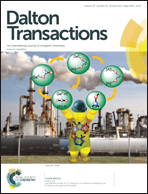An investigation on new ruthenium(ii) hydrazone complexes as anticancer agents and their interaction with biomolecules†
Abstract
A new set of ruthenium(II) hydrazone complexes [Ru(H)(CO)(PPh3)2(L)] (1) and [RuCl2(DMSO)2(HL)] (2), with triphenyl phosphine or DMSO as co-ligands was synthesized by reacting benzoyl pyridine furoic acid hydrazone (HL) with [Ru(H)(Cl)(CO)(PPh3)3] and [RuCl2(DMSO)4]. The single crystal X-ray data of complexes 1 and 2 revealed an octahedral geometry around the ruthenium ion in which the hydrazone is coordinated through ON and NN atoms in complexes 1 and 2 respectively. The interaction of the compounds with calf thymus DNA (CT-DNA) has been estimated by absorption and emission titration methods which indicated that the ligand and the complexes interacted with CT-DNA through intercalation. In addition, the DNA cleavage ability of these newly synthesized ruthenium complexes assessed by an agarose gel electrophoresis method demonstrated that complex 2 has a higher DNA cleavage activity than that of complex 1. The binding properties of the free ligand and its complexes with bovine serum albumin (BSA) protein have been investigated using UV-visible, fluorescence and synchronous fluorescence spectroscopic methods which indicated the stronger binding nature of the ruthenium complexes to BSA than the free hydrazone ligand. Furthermore, the cytotoxicity of the compounds examined in vitro on a human cervical cancer cell line (HeLa) and a normal mouse embryonic fibroblasts cell line (NIH 3T3) revealed that complex 2 exhibited a superior cytotoxicity than complex 1 to the cancer cells but was less toxic to the normal mouse embryonic fibroblasts under identical conditions.


 Please wait while we load your content...
Please wait while we load your content...